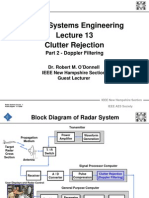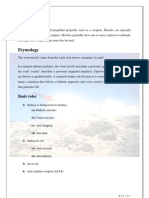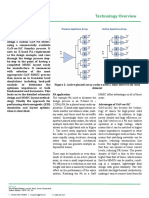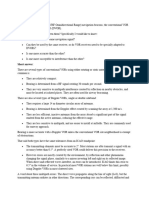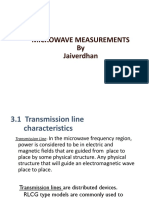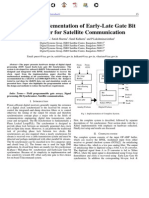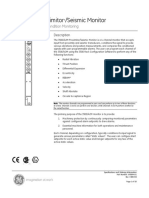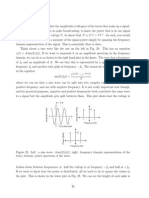Phased Array Antenna Calibration Method in Operating Condition - Rev Method
Uploaded by
Matthew CarterPhased Array Antenna Calibration Method in Operating Condition - Rev Method
Uploaded by
Matthew CarterCEOS-SAR01-085
PHASED ARRAY ANTENNA CALIBRATION METHOD IN OPERATING CONDITION - REV METHOD Isamu Chiba(1), Nobuo Kumagae(2), Rumiko Yonezawa(1), Ken-ichi Hariu(1), and Naoya Morita(1) (1) Mitsubishi Electric Corporation 325 Kamimachiya, Kamakura, Kanagawa 247-8520, Japan Phone : 0467-41-6165 / Fax : 0467-41-6952 Email : Isamu.Chiba@kama.melco.co.jp (2) Japan Resources Observation System Organization 2-20-1 Hatchobori, Chuo-ku, Tokyo 104-0032, Japan
ABSTRACT
A review on recent phased array antenna technologies is presented. The technologies referred to in this presentation are antenna calibration, low sidelobe pattern synthesis for conformal array antennas and density tapering for active phased array antennas.
& E
0
Ei e
j i
1. REV METHOD
To realize an active phased array system, precise phased array antenna calibration is necessary. The Rotating Element electric-field Vector (REV) method[1] is a method to determine the amplitude and phase values of the electric field vector radiated from each antenna element of a phased array under operation. Figure 1 shows the configuration of a phased array used as a receiving antenna. As shown in Figure 2, the composite electric field vector of the antenna array of Figure.1 in a specific direction is a superposition of the electric field vectors of the antenna elements. When the phase of an antenna element is changed by controlling the phase shifter, the composite field vector varies as the element field vector rotates. Measuring the amplitude variation of the composite vector, the amplitude and phase of the element can be determined as described hereafter. In Figure 2, the amplitude and phase of the composite field vector in the initial state are denoted by E0 and 0 , and those of the i-th element
E0e j
Figure 2. Composite field vector of a phased array antenna
Figure 3 indicates that the composite power varies sinusoidally as the phase of one of the elements changes. The relative amplitude K and relative phase X of the element are determined by the following equations[3]:
by Ei and i . When the phase of the i-th element is varied by , the composite field can be expressed as:
K=
1 + 2 cos 0 +
2
(3)
&= E e j 0 E e ji + E e j (i + ) E 0 i i
(1)
Here, the relative amplitude and relative phase of the i-th element are defined as follows:
sin 0 X = tan 1 cos + 0
(4)
E K= i, E0
X = i 0
(2)
Phase shifters
where is r 1 and r is the ratio of the maximum and r +1 minimum of the composite power, and 0 is the phase that gives the maximum value of the composite power. Here, we can detect the relative amplitude and phase distribution of the phased array in operation by changing the phase of each element one by one and measuring the change of the composite power.
E1e
Combiner
j 1 j
2
E2e
Max Power
EN-1e ENe
N-1
Min
Phase variation
Figure 1. Configuration of a phased array antenna.
Figure 3. Phase variation vs. composite power.
CEOS-SAR01-085
C0i
Figure 4 shows the low sidelobe pattern calibrated with REV method. This result verified that REV method is effective for accurate calibration of phased array antennas.
experim ented calculated
Tx
Rx
Figure 5. Configuration of On Board REV antenna.
3. REFERENCES
Figure 4. Resultant radiation pattern.
[1] S.Mano and T.Katagi :Trans. IECE Japan, J65-B, 5, pp.555-560,1982. [2] R.Yonezawa , I. Chiba and T. Katagi: IEEE Trans on AP,Vol.AP-47, No.3, 1998.
2. ON BOARD REV METHOD
For phased array antennas used in satellite or other mobiles, calibration must be carried out under actual operating condition, in most cases on the antenna apparatus. We call this condition as "On Board". REV can be applied to this "On Board" case. The procedure of this On Board REV is as follows: (1) Measure the electric field of mutual coupling (C0i) by REV method on Assembly Integration Test in a factory or test field. We call this as AIT. (2) Far field electric field of i-th element Fi is measured by REV method on AIT. (3) Memorize the difference between D0i = Fi - C0i. (4) Measure the electric field of mutual coupling C1i by REV method on board. (5) Adjust the excitation phase to D1i ( = Fi - C1i ) using D01 on board. The configuration of this procedure is shown in Figure.5. The On Board REV method was applied to calibrate the phased array antenna mounted on PALSAR (Phased Array Type L-band Synthetic Aperture Radar).
You might also like
- Pulse Doppler Radar - Principles, Technology, Applications (PDFDrive)No ratings yetPulse Doppler Radar - Principles, Technology, Applications (PDFDrive)428 pages
- Musical Applications of Microprocessors 2ed Chamberlin H 1987100% (5)Musical Applications of Microprocessors 2ed Chamberlin H 1987835 pages
- Wiley - Antenna Theory and Design, 3rd Edition - 978-0-470-57664-9No ratings yetWiley - Antenna Theory and Design, 3rd Edition - 978-0-470-57664-93 pages
- Real-Time Implementation of Melp VocoderNo ratings yetReal-Time Implementation of Melp Vocoder11 pages
- Noise Figure Measurement Using A Spectrum Analyzer and Signal Generator100% (1)Noise Figure Measurement Using A Spectrum Analyzer and Signal Generator4 pages
- AN - AAR-47B (V) 2 Electro-Optic Missile and Laser Warning SystemNo ratings yetAN - AAR-47B (V) 2 Electro-Optic Missile and Laser Warning System2 pages
- Richard A. Poisel - RF Electronics For Electronic Warfare (2019, Artech House)No ratings yetRichard A. Poisel - RF Electronics For Electronic Warfare (2019, Artech House)717 pages
- Examining The Efficacy of FHSS and OFDM Protocol For Drone CommNo ratings yetExamining The Efficacy of FHSS and OFDM Protocol For Drone Comm60 pages
- Multi-Channel Transmit/receive Modules For X-Band AesaNo ratings yetMulti-Channel Transmit/receive Modules For X-Band Aesa3 pages
- Radar Clutter Rejection Doppler FilteringNo ratings yetRadar Clutter Rejection Doppler Filtering67 pages
- DuPlessis Extended (2009) - Cross Eye JammerNo ratings yetDuPlessis Extended (2009) - Cross Eye Jammer4 pages
- Tactical Communications For The Digitized Battlefield - Michael J. Ryan - Artech 2002No ratings yetTactical Communications For The Digitized Battlefield - Michael J. Ryan - Artech 2002389 pages
- Direction of Arrival Estimation AlgorithmsNo ratings yetDirection of Arrival Estimation Algorithms14 pages
- Swarm Technology in Drones and Its ApplicationsNo ratings yetSwarm Technology in Drones and Its Applications20 pages
- Radar Cross-Section Measurement Techniques PDFNo ratings yetRadar Cross-Section Measurement Techniques PDF9 pages
- NI-Understanding RF Instrument Specifications 3No ratings yetNI-Understanding RF Instrument Specifications 34 pages
- Radar System Overview: Specialists in Defence & Aerospace SystemsNo ratings yetRadar System Overview: Specialists in Defence & Aerospace Systems27 pages
- FMCW Radar Is A Special Type of Radar Sensor Which Radiates: Frequency-Modulated Continuous-Wave RadarNo ratings yetFMCW Radar Is A Special Type of Radar Sensor Which Radiates: Frequency-Modulated Continuous-Wave Radar8 pages
- Ship Detection With DVB-T Software Defined Passive RadarNo ratings yetShip Detection With DVB-T Software Defined Passive Radar3 pages
- Theoretical Accuracy of Radar Measurements-Xd3No ratings yetTheoretical Accuracy of Radar Measurements-Xd37 pages
- LEO Satellite Constellation For Internet of ThingsNo ratings yetLEO Satellite Constellation For Internet of Things11 pages
- EW102-A Second Course in Electronic Warfare by David L Adamy0% (1)EW102-A Second Course in Electronic Warfare by David L Adamy2 pages
- Signal Processing Algorithms For MIMO Radar: Chun-Yang ChenNo ratings yetSignal Processing Algorithms For MIMO Radar: Chun-Yang Chen155 pages
- Detection and Tracking Algorithms For IRSTNo ratings yetDetection and Tracking Algorithms For IRST9 pages
- Military Laser Technology for Defense: Technology for Revolutionizing 21st Century WarfareFrom EverandMilitary Laser Technology for Defense: Technology for Revolutionizing 21st Century WarfareNo ratings yet
- Global Positioning Systems, Inertial Navigation, and IntegrationFrom EverandGlobal Positioning Systems, Inertial Navigation, and IntegrationNo ratings yet
- Propagation Modelling For Wireless Local Loop ChannelNo ratings yetPropagation Modelling For Wireless Local Loop Channel11 pages
- Radio Access Network Requirement For New Deployment of Wimax in DhakaNo ratings yetRadio Access Network Requirement For New Deployment of Wimax in Dhaka5 pages
- Ground-Plane Antennas For 144, 222 and 440 MHZNo ratings yetGround-Plane Antennas For 144, 222 and 440 MHZ2 pages
- Mobile Digital Datalink For Field Work ApplicationsNo ratings yetMobile Digital Datalink For Field Work Applications4 pages
- A Propagation Model For Mobile Radio Propagation Loss in An Urban Area at 800 MHZNo ratings yetA Propagation Model For Mobile Radio Propagation Loss in An Urban Area at 800 MHZ14 pages
- Evaluation of A Terrain-Based Point-To-point Propagation Model in The 900 MHZ BandNo ratings yetEvaluation of A Terrain-Based Point-To-point Propagation Model in The 900 MHZ Band7 pages
- Intelligent Behaviors For A Convoy of Indoor Mobile Robots Operating in Unknown EnvironmentsNo ratings yetIntelligent Behaviors For A Convoy of Indoor Mobile Robots Operating in Unknown Environments9 pages
- A Short Primer On Getting Started On 13 CM EMENo ratings yetA Short Primer On Getting Started On 13 CM EME6 pages
- Improved Uav Datalink Performance Using Embedded AntennasNo ratings yetImproved Uav Datalink Performance Using Embedded Antennas12 pages
- Design and Implementation of Early-Late Gate Bit Synchronizer For Satellite CommunicationNo ratings yetDesign and Implementation of Early-Late Gate Bit Synchronizer For Satellite Communication4 pages
- Measurement Functions: Fluke Timer Counters and Frequency Counters PM 6680B, PM6681, PM6685No ratings yetMeasurement Functions: Fluke Timer Counters and Frequency Counters PM 6680B, PM6681, PM66859 pages
- Telecommunication Systems 1: Prof. Dr. Tayfun AkgülNo ratings yetTelecommunication Systems 1: Prof. Dr. Tayfun Akgül46 pages
- Defect Source Location of A Natural Defect On The High Speed Rolling Element Bearing With Acoustic EmissionNo ratings yetDefect Source Location of A Natural Defect On The High Speed Rolling Element Bearing With Acoustic Emission7 pages
- 3500 - 42M Proximitor Seismic Monitor PDFNo ratings yet3500 - 42M Proximitor Seismic Monitor PDF18 pages
- (Ebook) Human Response to Vibration by Neil J. Mansfield ISBN 9780415282390, 041528239X download100% (1)(Ebook) Human Response to Vibration by Neil J. Mansfield ISBN 9780415282390, 041528239X download49 pages
- Rubber Property-Vulcanization Using Rotorless Cure Meters: Standard Test Method ForNo ratings yetRubber Property-Vulcanization Using Rotorless Cure Meters: Standard Test Method For7 pages
- Electronics Mechanic - Communication ElectronicsNo ratings yetElectronics Mechanic - Communication Electronics2 pages
- Liquid Dielectric Constant Meter: Model 871No ratings yetLiquid Dielectric Constant Meter: Model 8712 pages
- Control of Electric Drives - D. RamírezNo ratings yetControl of Electric Drives - D. Ramírez187 pages
- MX2 Training Program 07 UT ConfigurationNo ratings yetMX2 Training Program 07 UT Configuration44 pages
- 1.4 Signal Power: Time (Seconds) Frequency (HZ)No ratings yet1.4 Signal Power: Time (Seconds) Frequency (HZ)9 pages
- Harmonic Detection Using Microcontroller PDFNo ratings yetHarmonic Detection Using Microcontroller PDF4 pages













